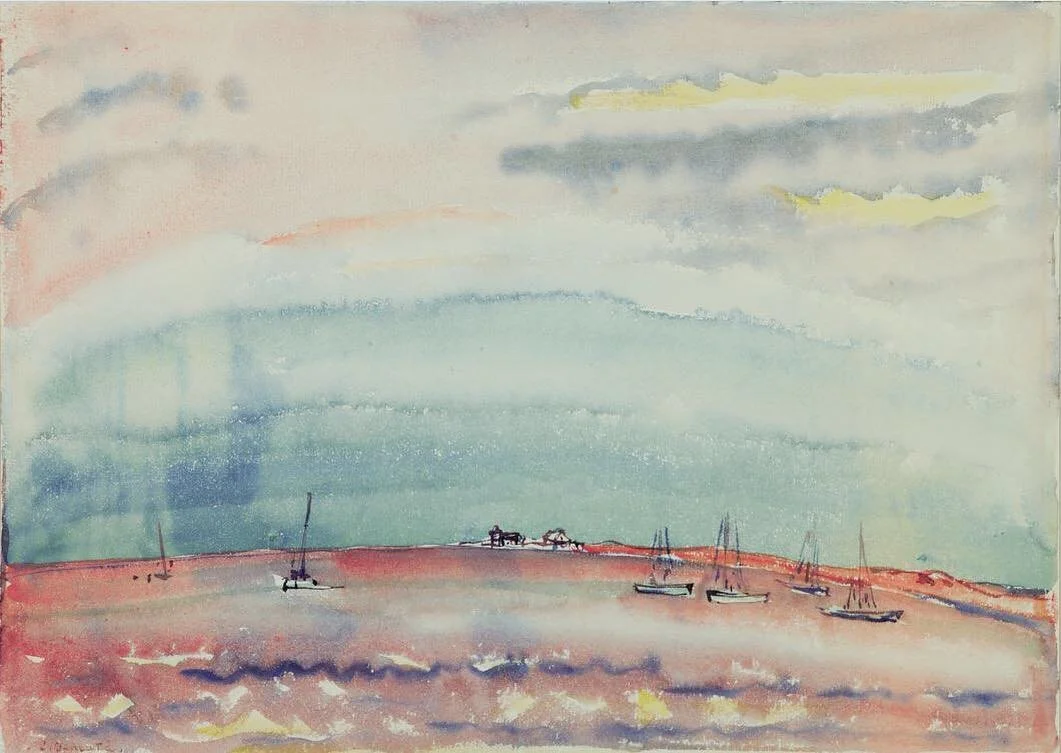Born in Lancaster, Pennsylvania in 1883, Charles Demuth found inspiration in his hometown throughout his lifetime. As an adult, Demuth traveled beyond Lancaster County’s borders where he continued to be influenced by his environment. To satiate his adventurous spirit, these travels included various locations in the northeast United States, multiple trips to Europe, and even an excursion to Bermuda. Often Demuth found respite by the water, whether looking out to sea in France, relaxing on the beach in Provincetown, or spending time along the Susquehanna River.
Wherever his journeys led him, he remained grounded in Lancaster’s varied and lush scenery to fuel his creative ambitions and always returned to his studio, home, and mother.
Click or tap on the images to open in full screen.
Charles Demuth, East King Street, 1908-10, watercolor on paper mounted on cardboard, collection of the Demuth Museum, gift of Robert F. Nation
EAST KING STREET - Lancaster City
Charles grew up on East King Street, a major thoroughfare across eastern Pennsylvania. The road was lined with shops and inns for travelers as they passed through or stayed in the city. Though nestled in Pennsylvania’s quiet agricultural heartland, Lancaster was a city of commerce, industry, and the arts. While Charles frequently traveled far from home, he always returned to Lancaster and drew much inspiration from the urban landscape, especially in his later years as his health declined.
Charles Demuth, Marine, c. 1912, watercolor on paper, collection of the Demuth Museum, gift of the Thomas A. and Georgina T. Russo Family Foundation in honor of Executive Director Anne M. Lampe
Marine - France
Charles spent a collective 4 years traveling and studying in France, over the course of three trips. He painted Marine in 1912 on his second journey across the Atlantic. He attended school in Paris and immersed himself in the avant-garde community there, while also traveling to the coast. Amidst his travels, Charles met many lifelong friends with whom he learned and worked alongside.
Charles Demuth, At Marshall’s, 1915, watercolor and graphite on paper, collection of the Demuth Museum, purchased with funds from The Anne L. and Robert K. Bowman Family Foundation, Mr. and Mrs. Eberhard Gromoll, Gerald and Margaret Lestz, Linda Lestz, Mrs. Caroline Steinman Nunan, Mr. and Mrs. Robert L. Schroeder, David H. Scott, and Donald Windham
At Marshall's - New York
Charles’ social circles drew him to New York City and the vibrant bohemian scene. Marshall’s was a favorite place of Demuth’s, a cultural hub during the beginning of the Harlem Renaissance. Demuth enjoyed socializing, hearing the earliest renditions of ragtime and jazz, and appreciating the latest in theater. In this painting, several of his friends like Marcel Duchamp, Edward Fisk, and Marsden Hartley are lounging around a table, presumably deep in jovial banter or conversation.
Charles Demuth, Man and Woman on the Beach, Provincetown, 1916, watercolor and graphite on paper, collection of the Demuth Museum, purchased with funds from Henry Kauffman and the acquisition fund
Man and Woman on the Beach, Provincetown - Provincetown
In the early 1900s artists began to flock to Provincetown, Massachusetts, the most northern point of Cape Cod, inspired by the windblown landscape and art schools. Demuth and his contemporaries and friends, like playwright Eugene O’Neill, joined the eclectic and well established community of Provincetown, where they expressed themselves freely in the company of other artists. Demuth spent several summers there, including in 1916 when he painted this seaside scene.
Charles Demuth, Sunnyside Mural, 1930, gouache on canvas, collection of the Demuth Museum, gift of the owners of Sunnyside Farm and restoration courtesy of Steinman Foundation
Sunnyside Mural - Gap, PA
The Sunnyside farm was the summer and fall vacation home of Isaac Hull Stauffer III and his family. Stauffer often hosted gatherings for his friends on the estate, which served as an escape from the stuffy life of the city and a place to party discreetly in the midst of Prohibition. As a playful, surprise thank you to their host, several of the Stauffers’ artist friends, including Demuth, painted a mural in the cocktail room. Demuth drew inspiration from the names of surrounding towns to design a “family crest” clearly grounding the mural in Lancaster County, a place they all held dear, but not taking it too seriously.
Charles Demuth, Mermaid on Dome, n.d., graphite on paper, collection of the Demuth Museum, gift of Mr. Harris C. Arnold
Mermaid on Dome - Atlantic City
Charles visited the New Jersey shore, traveling to Atlantic City. Demuth and other East Coast elites vacationed in the resort town to indulge in the extravagant entertainment and nightlife. The hotels, clubs, and restaurants along the boardwalk were topped with rounded domes and decorative finials that caught the eye. While the location of this mermaid is unknown, similar adornments were a common sight on a stroll along the boardwalk.
Charles Demuth, Landscape, Peach Bottom, 1931, oil on canvas, collection of the Demuth Museum, gift of Charles Conrad
Landscape, Peach Bottom - Lancaster County
Peach Bottom, a name claimed by rural enclaves in both York County and across the Susquehanna River in Lancaster County, had a railroad depot and ferry to connect the two communities along the waterway. This piece is dated 1931, after the original Peach Bottom was flooded in 1928 with the construction of a dam downstream in Maryland. Present day Peach Bottom was rebuilt to the southeast and remained an idyllic piece of Lancaster countryside.
Charles Demuth, Three-Masted Schooner, c. 1916-17, charcoal, wash, and pencil on paper, collection of the Demuth Museum
Three-Masted Schooner - Bermuda
Demuth spent several months in Bermuda with his friend and fellow artist Marsden Hartley in 1916. In the midst of WWI, the artists may have looked for a vacation away from Europe, and the British colony of Bermuda, a port for trading vessels and naval bases, had begun to market itself for tourism. The beaches of the Atlantic island would have provided a tropical respite with plenty of maritime activity to behold, though this type of vessel, already 100 years in use, may have been for quicker coastal travel than that of the high seas.
Charles Demuth, Lambertville, c. 1911-1912, watercolor, collection of the Demuth Museum
Lambertville - New Hope, PA
Lambertville is a small town that arose along the Delaware River, as an early midpoint stop for travelers between Philadelphia and New York City. It expanded during the industrial boom of the mid 19th century, an important stop for barges shipping cargo up the canal. Wealthy factory owners and merchants settled in the countryside to the north. By the turn of the century, the enclave was facing economic decline, but remained a picturesque enclave in southern Pennsylvania, outside the bustling metropolises of Trenton and Philadelphia. The canal here reflects the quaint town along the shore.

